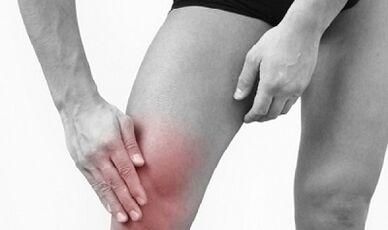
One of the most common muscle-bone systems is a common knee arthrosis (otherwise gonartrosis) is a chronic disease, accompanied by the dystrophy and destruction of the hitch art structures.
The result of destructive processes is a sharp limit or complete loss of common mobility, and as a result - reduction in performance, disability.
It is possible to prevent harmful consequences only if you are early diagnosed and therapy on time.
Reasons
Originally, the arthrosis of the knee is primary and medium.Primary development as an independent disease is more commonly diagnosed in older people, and in this case it occurs due to age changes that occur in tissues.Secondary gonortiness becomes the result of other diseases and disorders in the body.
Gontrose development contributes:
- Injuries (dislocations, fractures, meniscus damage);
- Diseases of the muscle-bone system (inborn deformation of the legs, knee dysplasia, hondrocalcinosis, arthritis, osteoporosis);
- Constant large loads on the joint due to professional activities, professional sports;
- surplus weight, obesity;
- Endocrine diseases, including diabetes, hypothyroidism, acromigal;
- Metabolic disorders;
- Genetic predisposition.
Symptoms
Inflammation with the arthrosis of the knee joint is followed by two main clinical manifestations - pain and edema.The intensity and frequency of pain depend on the depth of damage to articulated structures.In the initial phase, the pain feels only with the cargo, quickly passes in rest.With advanced gonortiness, pain in pain is constantly constituted, amplified during the movement, with a change of time.
Other signs of a joint knee arthrosis:
- Crunch when moving;
- stiffness in the joint, violation of the engine function;
- Knee deformation (with neglected gonartrosis).
Gonartnostriza can be accompanied by sinovitis (accumulation of liquid in a common cavity) and the subsequent formation of a bakery cyst (elastic formation at the back of the knee).
Degree of arthrosis
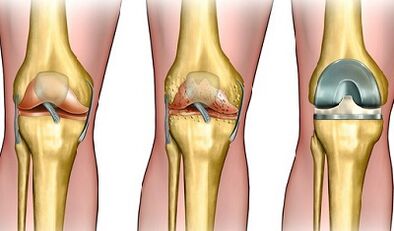
The symptoms of the knee joint arthros differ depending on the depth of damage structures, and thus 3 phases of pathology.
- ARTROSE OF THE COOPERAL KINE 1 degreeIt is manifested by weak painful painful load (in rest passes at once), with a mild solidness after sleep.The presence of individual osteophytes (bone system) was noticeable in the radiographic image, noticeable narrowing of the joint gap.
- Arthrosis of shared knees 2 degreesIs accompanied by a painful and characteristic crisis during the movement.The pain takes a while at rest.Morning numbness was recorded, the restriction of the amplitude of the movement.Diagnostic procedures reveal a pronounced narrowing of the common gap (more than half) and multiple osteophytes.
- Knee Arthrosis 3 degreesFollow in constant painful pain, which amplifies during movement and at night.Morning stiffness remains longer than an hour with worsening inflammation and at least half an hour - in the periods of remission.The joint mobility is sharply restricted or completely lost.More large osteophytes, cysts are visible in the radiographic picture.The joint gap narrows more than two-pork from the norm.
Depending on the degree of knee joint arthrosis, the patient is prescribed conservative or surgical treatment.
Diagnostics
The diagnosis of the knee joint arthroses includes a visual overview, the analysis of the patient's complaints, laboratory tests (urine analysis, general and biochemical blood tests) and instrumental testing methods.
The following diagnostic procedures allow you to confirm or refute the diagnosis:

- radiography;
- Ultrasound (ultrasound);
- MRI (magnetic resonance);
- CT (calculated tomography);
- Arthroscopy and scintigraphy (with a tumor suspicion).
Using these methods, it is possible to discover the narrowing of the common spacing, the deformity of the cartilage, the presence of fluid in the joint cavity, structural changes in the synovial membrane, growth of osteismic and hotspots in the form of cartilage.
Conservative treatment
Conservative treatment methods can reduce pain and inflammation, improve blood circulation and periastatic tissue nutrition, strengthen muscle appliances.
For this purpose they are held:
- Drug therapy;
- blockade;
- Physiotherapy and manual therapy;
- Medical physical education.
An important component of the treatment of arthrosis is compliance with a therapeutic diet.
The conservative treatment of the joint knee arthrosis will be effective in the initial phase of the disease, when smaller dystrophic cartridges, inflammation and damaged sinovial shellfish.
Drug
Drug treatment includes meeting:
- Not -steroidal anti-inflammatory drugs (NSAID);
- Chondroprotectors;
- Hyaluronic acid.
Nsaid
Not -steroidal anti-inflammatory drugs help mitigate inflammation, reduce your main symptoms - edema and pain.
Preparations are prescribed in the form of a solution (for intramuscular administration) or tablets, capsules (for oral administration).Capsules and tablets from the NSAID knee joints are transmitted in short courses, as medicines have a strong irritating effect on the stomach for gastric mucosa and can cause a peptic ultra-efficiency.
Additionally prescribed external drugs (fats, gels, creams) based on non-persons-faced anti-inflammatory components.Local therapy is allowed to spend a long time.
NSAIDs have a pronounced anti-inflammatory effect, but with extended use contribute to additional crunchy destruction.
NSAIDs are symptomatic therapy.They help to remove unpleasant symptoms of the disease, but do not affect the state of cartilage.Unlike these products, hondroprotectors and hyaluronic acid accelerate the processes of the racking tissue regeneration and slow down its destruction.
Chondroprotectors
HondroProtectors Group medications contain hondrroitin and glucosamine (structural cartilage elements) and help restoring the knee arthrosis knee.They are available in the form of tablets, oral administration powder, injection solution.
The minimum course of introducing pills and powder is 3 months.After the break, the course is repeated 2-3 times.The course of treatment with a solution includes 12-15 injections, repeated 2-3 times a year.
The first positive treatment results of hondroprotectors are not only a few months after the beginning of therapy.
Hyaluronic acid
Hyaluronic acid is entered in injects into affected joint.The cure for the knee joint arthrosis performs the role of lubrication - wrapping surface wraps, thus reducing friction between them.
Hyaluronic acid therapy medications helps increase cartilage tissue elasticity, prevents further destruction of articulated structures, which improves the mobility of shared, symptoms of inflammation decreased.Medications are well tolerated, do not cause side effects.Their only lack is high costs.
The flow of treatment with hyaluronic acid usually includes 3-4 injections, which are carried out with pauses of 10-14 days.
Blockade
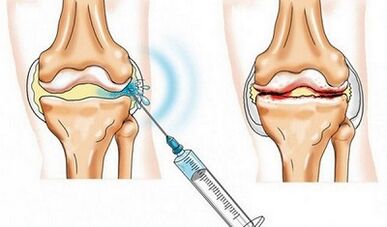
If with non-atleine -inflammatory drugs, it is not possible to alleviate the knee pain, the lock is performed - the treatment method in which medications are injected directly into the affected pain and inflammation tissues.In the therapy of arthrosis, the joints (injection in the articulated cavity) and periarticular (in the perial cavity) blockade.
The main advantage of the method is the current purposeful action, because with such an introduction, the maximum concentration of the active substance is created in the West Zone.In addition, drugs do not fall into the systemic bloodstream, which significantly reduces the risk of unwanted reactions.
In the later phases of Gonartosis, the articular gap on the narrow, osteophytes grow, the surfaces of the joints are deformed, so only peraccular blockade is allowed.
The blockade of the wrist knee for arthrosis can be performed using the anesthetics and corticosteroids.
Anesthetics are usually introduced in combination with steroid hormones to reduce the pain of the procedure.
Hyaluronic acid and hondroprotectors can also be introduced directly into the wrist.But in this case we do not talk about the blockades, but about intra -ticular injection, because these medications do not block the impulses pain, but run the processes of the Hartilage tissue regeneration.
Physiotherapy and hand therapy
The main methods of physiotherapy effects used in the treatment of arthrosis include:
- Laser treatment;
- Ultrasonic therapy;
- cryotherapy;
- paraffin and ozoker therapy;
- Blato.
The main task of all physiotherapy procedures is to encourage blood circulation in nearby tissues, improve the nutritional nutrition.
Practice therapy
Cheese pain forces a patient with gonartrosis to limit motor activities, as a result of which in the vicinity of the ligaments and muscles of atrophy.This condition negatively affects common tissues, because during the movement that nutrients penetrates from the Sinovi liquid to the cartilage.If a combination is constantly at rest, dystrophic processes are worsening.
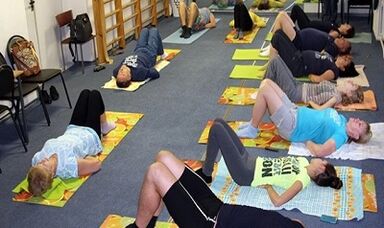
Therefore, the exercises are physiotherapy an integral component of conservative therapy.Moderate physical activity allows you to strengthen muscle appliances, improve the power of articulated structures, eliminate stiffness and improve your knee engine function.
Therapeutic exercise exercises develops a doctor individually for each patient taking into account the depth of the lesion and the functional state of articulated structures.
General recommendations for conducting therapy with exercise for arthrosis joint knees:
- Start classes only after stopping the signs of acute inflammation;
- Complete all exercises smoothly, without sudden movements;
- Load increases gradually;
- Eliminate high loads on the compound (improved flexion / knee extension);
- If pain or discomfort occurs, stop training.
Diet
With gonartrosis, products containing: containing:
- Amino acids (dairy products, low meat variability variabars);
- collagen (gelatin utensils);
- irreplaceable fatty acids (vegetable oils, fish);
- Sulfur and selenium (legumes, cereals, cabbage and apples, beef, chicken, eggs).
It is also important to:
- Eliminate the use of smoked meat, acid cucumbers, marinade;
- Border consumption of salt;
- adhere to 5-folding diet;
- Follow the drinking mode.
Excess body weight is one of the main factors that cause development of the knee joint arthrosis.Therefore, the task of patients with excess weight dropped body weight.In this case, you can only achieve the result with the help of diet, because intensive sports are harmful to the inflated compound.
To reduce body weight, turn off from the menu:
- Fatty varieties of meat and fish;
- cream, domestic sour cream and other dairy products with a high percentage of fat content;
- Margarine, mayonnaise, various sauces;
- Confectionery products;
- Fast food;
- Cute drinks.
Surgical treatment
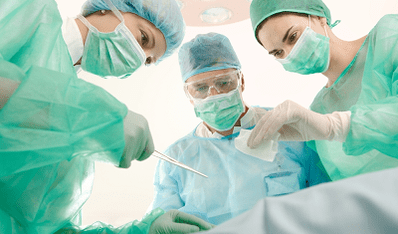
Arthrosis of connecting knees in 3. The degree is not subject to conservative therapy, so the operation is the only way out for the patient.
There are two options for surgical intervention:
- Corrective osteotomy- is carried out in the initial stage of development 3. Gonartroza phase, if the cartilage is partially destroyed, it is possible to remove osteofite;
- Endoprosthetics- The wrist replacement or its destroyed parts is performed with complete destruction of cartilage.
Forecast
Pathological changes in articulated structures are progressive, irreversible.However, with an early diagnosis and proper treatment you can completely stop inflammation and stop dystrophic changes in the paper tissue - the knee joint arthrosis in 1. the degree is well-maintained for conservative therapy.
With the arthrosis of the second degree that accompanies the destruction of cartilage and formation of osteophytes, conservative methods allow you to slow down or suspend the briskid deformation, stop inflammation and improve engine activity.However, doctors are often forced to resort to blockage, arthroscopy.
It is impossible to cure the knee arthrosis to 3 degrees in a conservative way.The only way to return the mobility of the knee is surgical intervention.

























